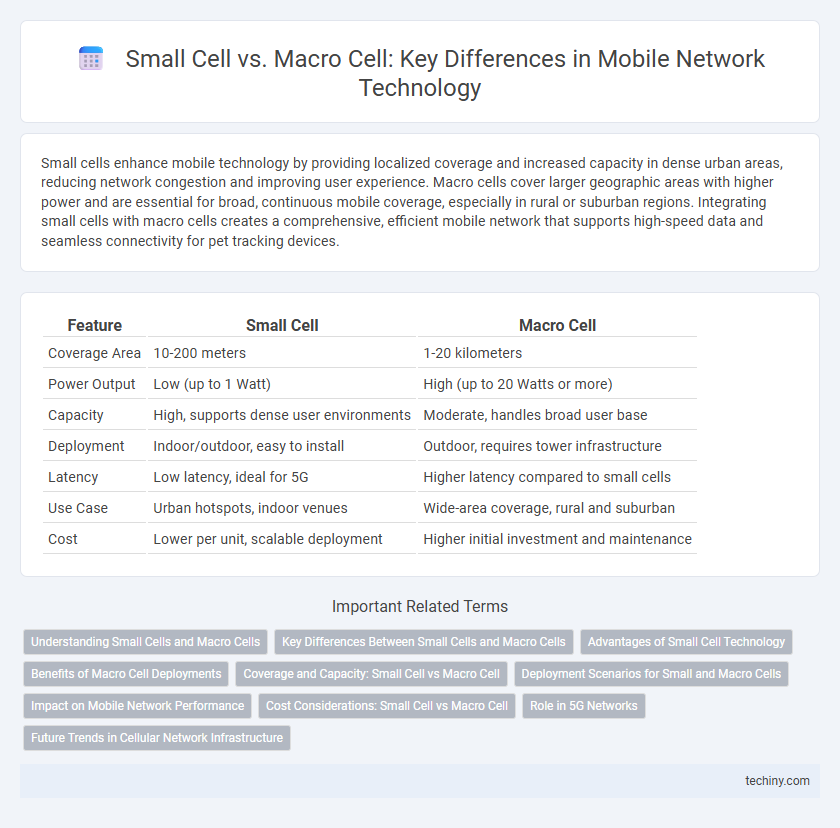Small cells enhance mobile technology by providing localized coverage and increased capacity in dense urban areas, reducing network congestion and improving user experience. Macro cells cover larger geographic areas with higher power and are essential for broad, continuous mobile coverage, especially in rural or suburban regions. Integrating small cells with macro cells creates a comprehensive, efficient mobile network that supports high-speed data and seamless connectivity for pet tracking devices.
Table of Comparison
| Feature | Small Cell | Macro Cell |
|---|---|---|
| Coverage Area | 10-200 meters | 1-20 kilometers |
| Power Output | Low (up to 1 Watt) | High (up to 20 Watts or more) |
| Capacity | High, supports dense user environments | Moderate, handles broad user base |
| Deployment | Indoor/outdoor, easy to install | Outdoor, requires tower infrastructure |
| Latency | Low latency, ideal for 5G | Higher latency compared to small cells |
| Use Case | Urban hotspots, indoor venues | Wide-area coverage, rural and suburban |
| Cost | Lower per unit, scalable deployment | Higher initial investment and maintenance |
Understanding Small Cells and Macro Cells
Small cells are low-power cellular nodes that enhance coverage and capacity by offloading traffic from macro cells, typically deployed in dense urban environments or indoor locations. Macro cells are high-power base stations providing wide-area network coverage and supporting large numbers of users across broader geographic regions. Understanding the complementary roles of small cells and macro cells is crucial for optimizing network performance and ensuring seamless mobile connectivity.
Key Differences Between Small Cells and Macro Cells
Small cells and macro cells differ primarily in coverage area and power; small cells cover limited areas such as indoor spaces or urban hotspots with low power, while macro cells provide wide-area coverage with high transmission power. Small cells enhance network capacity and reduce latency by offloading traffic in dense environments, whereas macro cells establish broad network coverage essential for mobile connectivity over large geographic regions. Deployment complexity and cost also vary, with small cells being more cost-effective and easier to install in targeted locations compared to the extensive infrastructure required for macro cells.
Advantages of Small Cell Technology
Small cell technology enhances network capacity and coverage by providing localized signal strength in high-traffic areas, resulting in improved indoor connectivity and reduced latency compared to macro cells. These compact base stations enable efficient spectrum reuse and lower deployment costs due to their smaller size and easier installation in urban environments. Small cells support higher data rates and seamless handoff in dense networks, making them essential for 5G and future mobile communication standards.
Benefits of Macro Cell Deployments
Macro cell deployments provide extensive coverage areas, supporting high user densities and seamless connectivity in urban and suburban environments. They deliver strong signal strength and better penetration through obstacles, ensuring reliable service across larger geographic regions. Macro cells also offer robust capacity for voice and data, enabling efficient network management and improved performance for mobile users.
Coverage and Capacity: Small Cell vs Macro Cell
Small cells enhance network capacity by providing localized coverage in high-density areas, reducing congestion and improving data rates. Macro cells deliver broader coverage across wide geographic regions, supporting high mobility users but may experience capacity limitations in densely populated zones. Deploying small cells complements macro cells by filling coverage gaps and increasing overall network capacity in urban environments.
Deployment Scenarios for Small and Macro Cells
Small cells are deployed in dense urban areas, indoor environments, and locations with high user density to enhance coverage and capacity by filling coverage gaps and offloading traffic from macro cells. Macro cells serve as the primary infrastructure for broad geographic coverage, providing wide-area connectivity and handling large-scale mobile traffic across suburban and rural regions. Efficient deployment of small and macro cells together creates a heterogeneous network that optimizes network performance, user experience, and resource utilization.
Impact on Mobile Network Performance
Small cells enhance mobile network performance by increasing capacity and coverage in high-density areas, reducing latency and improving data speeds through localized signal transmission. Macro cells cover larger areas with higher power, providing broad network coverage but often facing challenges like congestion and signal interference in urban environments. Integrating small cells with macro cells optimizes network efficiency, balancing widespread coverage with targeted capacity enhancements to support growing mobile data demands.
Cost Considerations: Small Cell vs Macro Cell
Small cells offer a cost-effective solution for increasing network capacity and coverage in dense urban areas due to lower deployment and maintenance expenses compared to macro cells. Macro cells require significant investment in infrastructure, such as towers and backhaul, leading to higher capital and operational costs. Small cells enable targeted coverage enhancements while reducing overall expenditure by leveraging existing structures and simplifying installation processes.
Role in 5G Networks
Small cells enhance 5G networks by providing localized high-capacity coverage and improving signal strength in densely populated urban areas and indoor environments. Macro cells offer broad coverage and support wide-area mobility, essential for maintaining continuous connectivity across cities and rural regions. Together, small cells and macro cells form a heterogeneous network architecture that optimizes 5G performance, capacity, and reliability.
Future Trends in Cellular Network Infrastructure
Small cells are poised to play a crucial role in the evolution of cellular network infrastructure by enhancing 5G and emerging 6G capabilities through improved coverage and capacity in dense urban areas. Macro cells will continue to provide broad area coverage and serve as the backbone for large-scale mobile networks, but future trends emphasize integrating small cells to support ultra-low latency and massive device connectivity required by IoT and smart city applications. Advancements in network densification, edge computing, and AI-driven network management will drive the seamless coexistence of small and macro cells, enabling more efficient, high-speed, and resilient mobile technology ecosystems.
Small Cell vs Macro Cell Infographic

 techiny.com
techiny.com